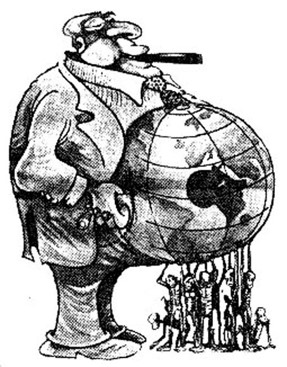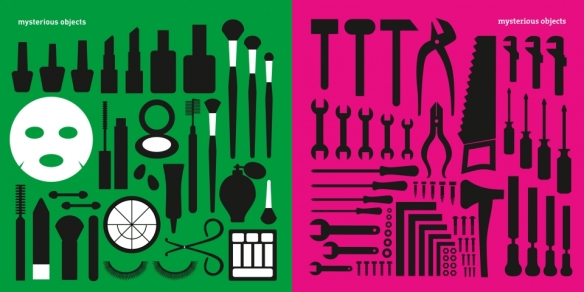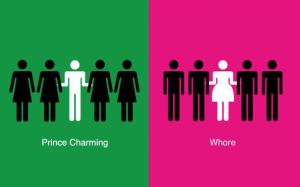
Released with Routledge January 2018
In January of 2018 my first book (based on my PhD research) Queering Femininity: Sexuality, Feminism, and the Politics of Presentation was published with Routledge. I also made the book into a zine for people to engage with given the prohibitive price tag. Queering Femininity engages with both an archive of Western feminist texts and interviews with self-identified queer femmes from the LGBTIQ community in Australia, in order to think through the queer potential of femininity. By ‘queer potential’ I mean, can we ever think about femininity as something that disrupts or ‘makes strange’? Or must we see femininity as always already problematic if we are to engage with it critically?

My zine based on the book
As I found in my analysis of feminist texts, there is (unsurprisingly) a long history of feminist critiques of femininity, where feminine styles of the body are understood as evidence of patriarchal oppression. Here, what is identified as femininity is often collapsed into surface and “masquerade”, even when talking about behaviors or roles. This issue of feminine styles causes issues for those who identify as queer femme, who often find themselves in a space of being unrecognisable as queer in both straight and LGBTIQ contexts (they are assumed to be heterosexual). Yet, I also found that the queer femme response to the inability of the world to see the queer potential of femininity was frequently to over-invest in feminine surface styles (for example, through exaggeration or attempting to signify queer ‘mistakes’ in their presentation). It seemed to me that in many cases this contributed to anxiety about being “queer enough” – an outcome that seemed antithetical to the concerns raised by queer femmes in the first place.
The argument that I attempt to make in response to this conundrum can be summed up in this lengthy paragraph from the conclusion:
To identify precisely who will always fail and who won’t, and in which ways, coheres the normative versus non-normative in ways that misdirect our energies. The aim of all of this must be to see that everyone is failing to meet normative expectations all the time. Everyone’s gender has queer potential precisely because of this ever-present failure. How-ever, we generally only imagine failure as going in one direction: not enough. That is, failure as a failure to meet expectations. However we can also understand failure in terms of “too much”. This is the realm of the “hyper”, the “fake”, the “excessive”. We often refer to “hyperfemininity” but don’t clearly articulate what this means. But we can understand this as meaning the “too much” – too much makeup, too much hair, the heels that are too high, the dress that is too short, the breasts that are too big, the desire that is too rampant, and so on. Interestingly femme often positions itself in this space of the “too much”, the overdone, failing femininity. However, we ought not to rely on the “too much” (or the “not enough”) as our site of resistance because a new norm inevitably fills this space – the norms of not being “too much” or “not enough” (expressed as “not queer enough”). In this way, I take the idea of queer failure to be incredibly useful, but I disagree with Halberstam that “all our failures combined might just be enough, if we practice them well, to bring down the winner” (2011, 120). Under such a rubric, those femmes who would dance around so-called normativity, who manage to “pass” as heterosexual, and who fail to fail enough are sidelined as irrelevant, or assimilationist. Such a view misses the necessity of adaptability to normative fantasies, and the need to pass, or the desire to. While we might imagine a world where our desires could go in different and changing experimental directions, it cannot be overlooked that imagined normative spaces offer cruel but necessary shelters. With this recognition we need not celebrate norms or anti-norms as emancipatory, but rather see that the necessity of such spaces only emerges under conditions where survival is key (2018, 144).
One of the key points I was trying to make in Queering Femininity is that in response to oppressive constructs we too often invest in our individual bodies and identities as the site of the political. This works to dismiss the complex attachments and relations with our bodies and identities that cannot so neatly be enrolled in political projects without serious psychic consequences. Yet, we must still acknowledge that there are normative “ideals” of femininity that are celebrated and encouraged in society, and conversely there are non-normative ways of being (“non-ideals”) that are punished and regulated in violent ways.
Since publishing the book I’ve been thinking a lot more about these claims and how we can effectively think through the relationship between norms, structure, and the activism we commit ourselves to in order to challenge these ideals in productive ways.
 I like to think in visual terms, and the diagram above (click on it to enlarge) is an attempt to sum up how we might connect structure, activism, and norms in a useful way. I’ve included a hammer here as a kind of nuanced update to that “If I had a hammer” image.
I like to think in visual terms, and the diagram above (click on it to enlarge) is an attempt to sum up how we might connect structure, activism, and norms in a useful way. I’ve included a hammer here as a kind of nuanced update to that “If I had a hammer” image.
This above diagram relates to an Australian context, as a way to localise this discussion and acknowledge that alternative versions of this are needed for different contexts (even if structures are the same, their expression in local contexts may have wildly different effects in terms of “ideals”). This diagram reflects that “ideals” require an oppositional “non-ideal” in order to be intelligible (i.e. make sense). Yet rather than simply presenting the ideals versus non-ideals (which might suggest to the reader that we ought to invest our politics in embodying the non-ideals), this diagram attempts to unpack the activism, ideologies and structure that keep this system of ideals versus non-ideals propped up.
 At the very base are the “structural foundations”, which accounts for the economic, colonial, and gendered power structures that are the foundation of the dominant organisation of social relations in this context. Flowing from this foundation, but also feeding back into it, are the dominant ideologies that invest in and maintain these social relations. For example, neoliberalism is an ideology that supports capitalism. Similarly White supremacy is an ideology that supports imperialism. Flowing from this, there are various forms of activism that respond to these ideologies in ways that either bolster these ideologies or reject them. The activism that bolsters these ideologies also works toward cementing what is understood as the “ideals”.
At the very base are the “structural foundations”, which accounts for the economic, colonial, and gendered power structures that are the foundation of the dominant organisation of social relations in this context. Flowing from this foundation, but also feeding back into it, are the dominant ideologies that invest in and maintain these social relations. For example, neoliberalism is an ideology that supports capitalism. Similarly White supremacy is an ideology that supports imperialism. Flowing from this, there are various forms of activism that respond to these ideologies in ways that either bolster these ideologies or reject them. The activism that bolsters these ideologies also works toward cementing what is understood as the “ideals”.
 It is clear for example, that heteroactivism supports the feminine ideals of heterosexuality, cisgender identity, reproductive bodies, etc.
It is clear for example, that heteroactivism supports the feminine ideals of heterosexuality, cisgender identity, reproductive bodies, etc.
However, some activism that rejects the underlying dominant ideologies also inadvertently invests in “non-ideals” as a response. For example, lesbian separatist projects advocate for the “non-ideal” of homosexuality, as a political response to heterosexist ideologies. What this does is cement the boundary between the ideal and the non-ideal, by investing in the non-ideal.
This leads us to the heart of the debate around assimilation versus transgression: how ought we to respond politically to “ideals” without simply creating a new set of normative non-ideals in opposition?
This is where the hammer comes in. This represents activism that invests in neither the ideals nor the non-ideals as the political solution. For example, we can imagine forms of queer feminism that challenge ideologies of sexism, heterosexism, cissexism and so forth without advocating queer exceptionalism. The activisms listed on the hammer aren’t necessarily mutually exclusive, so much as drawn out to show how they might go to the heart of challenging the (capitalist, colonial, gendered) structures at the base of ideals of femininity without rejecting or investing in femininity as a style of the body.
 Perhaps this is what might mark out a new wave of (feminist and other) activism around femininity: challenging gender ideals without investing in non-ideals as the political response. From such a perspective, there is no femininity that is “empowered”. Power is exerted and ideals are enforced, but the reaction to this is to focus on the structural foundations and their ideological props rather than the individual effects alone (which might for some involve complicated attachments).
Perhaps this is what might mark out a new wave of (feminist and other) activism around femininity: challenging gender ideals without investing in non-ideals as the political response. From such a perspective, there is no femininity that is “empowered”. Power is exerted and ideals are enforced, but the reaction to this is to focus on the structural foundations and their ideological props rather than the individual effects alone (which might for some involve complicated attachments).
I’d love to hear what you think in the comments below. Does this work at all? Is it useful? Is there anything in the wrong place, or missing altogether? What might this look like in your context? And a reminder: this is only one theory, and, a work in constant progress.













